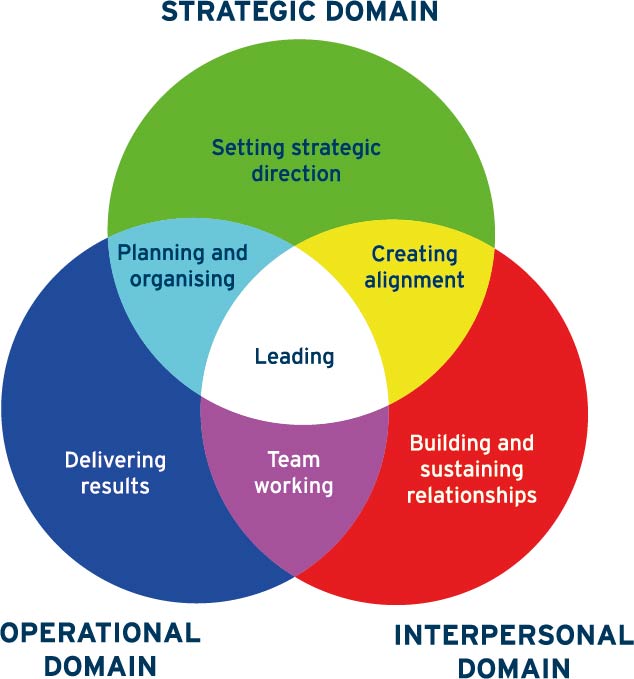Part 3: A leadership coaching journey – Analysing the business plan
September 30, 2019
This is the final instalment of an exploration of one person’s leadership coaching experience. This is a real client, who kindly agreed to become a case study, with details changed to maintain his anonymity. “Andrew” was the newly appointed MD of an IT company employing around 150 people. In the first instalment, I looked at coaching conversations related to Andrew’s working relationships. Last month I looked at delegation and team working. This month, I’ll be looking at Andrew’s plans for the business. In reality these conversations were intertwined and did not happen as neatly as this.
Returning to my go-to leadership model, it was clear that Andrew needed to focus his attention on the interpersonal domain and on establishing himself as a leader. But that didn’t mean that he could ignore the operational and strategic domains of leadership. 
The Operational Bit
Andrew had inherited a business that was doing well operationally. They made a healthy profit and had secure, long-term contracts that, barring catastrophe, guaranteed a predictable revenue stream. Sure, he could see operational efficiencies to be made in some places but it didn’t seem that this was an area demanding a huge amount of his attention when he took over. That may sound blindingly obvious but deciding what to focus on is a leadership skill in its own right. A lot of leaders waste time doing the things that interest them or are in their comfort zone. I encouraged Andrew not to get too bogged down in tracking results but to ensure there was nothing that demanded immediate attention.
What surprised Andrew when he dug a little deeper was that some contracts were making a loss. His predecessor, Tony, had kept tight control of the accounts. Not even the board was aware of the extent of the cross-subsidies. It seemed that Tony had believed that some markets were worth staying in, even if it cost money to do so. Andrew disagreed and started planning to either make these contracts profitable or exit them.
Back to the people bit
Although this was an operational issue, the interpersonal aspects loomed large. Andrew had already worked out that, under Tony’s management, he was the only senior manager who had any real autonomy. He was also the only one who managed his own budget. His colleagues didn’t know the financial position of contracts within their remit. Some of them were in for a nasty surprise.
Andrew didn’t see this any reflection on his colleagues. They weren’t responsible for the situation. He just wanted to present them with the facts. I reminded him that my assessment of him when he got the job had revealed that he was much more objective and robust about business matters than most people. How did he think those who took things more personally might feel when they discovered that their hard work and good service to clients had actually cost the business money? Andrew formulated a gentler, more sensitive approach to the situation as a result.
The strategic bit – where next?
Strategy was Andrew’s strong point; it would have been very easy for him to focus on this. He had loads of ideas about where he wanted to take the company. He was wise enough to recognise that this was not his immediate priority but he started to prepare ideas for 18 months’ time.
On one of our walks, we were discussing the power of a strong organisational narrative. I asked Andrew for his story of the company. “When we started out”, he said, “we were the disruptive technology of our day. We really shook things up in the industry. But then we got bigger and safer and we have contracts to deliver. We say we’re innovative but we’re not really. I want us to be disruptors again.” An analogy came to me; the company, I suggested, had started out as a punk band and morphed into stadium rockers. This resonated immediately with Andrew, a big music fan. I asked him to remind me of the timelines. The company started 25 years ago, but Andrew joined only 10 years ago. “You’re Ronnie Wood*”, I told him. Andrew was harking back to a golden era in which he played no part. How would it be if Mick Jagger retired, Ronnie Wood took over and tried to take the band back to its roots? We also discussed the fact that a lot of the staff had chosen to join a slick stadium rock band and might not be happy to find themselves part of a punk or blues band playing in dodgy bars. How could he recapture some of that spirit without seeming to take the organisation backwards?
What could I offer in the strategic domain?
I’m a psychologist not a strategy consultant; it wasn’t my job to tell Andrew whether his strategic ideas were sound. But I could ask the right questions. For some of my clients, acting as a sounding board for their ideas is a role I can usefully play. Andrew needed a bit of this but actually he was better off working through his ideas on his own. He wasn’t someone who needed to think out loud. Where I came in was to address his blind spot – helping him think through how his ideas would land with others. It’s the yellow bit in the Primary Colours® model: Creating Alignment. We looked at how he could shape a vision to sell to the board, the SLT and the rest of the staff. What was the compelling need for change? How might different key players respond to his ideas? When should he broach ideas and how well-formed should they be? How could he involve others in formulating his ideas? It was a very different approach from his default of locking himself away and emerging some time later with a perfectly crafted plan.
Where did we end up?
When we started the coaching, Andrew’s appointment was not universally popular. People feared he would be too tough and there were rumours of possible resignations. We ended the coaching, after six sessions over about eight months, with an informal 360-degree feedback exercise, involving board members, SLT and other colleagues and a few customers. To Andrew’s delight, he was widely described as approachable with a good sense of humour. Far from being feared, his direct reports’ main complaint was that they didn’t get enough of his time on a 1:1 basis. He was lauded for his clear commitment to the company; people believed he had the vision and ability to take it forward. Graham, the Chairman, who had been one of the doubters, said there was no question that Andrew was now seen as the leader of the business. Whilst people could see he had great ideas, however, he came in for criticism for over-intellectualising. There was still work to do to translate his big picture, conceptual thinking into something more tangible.
The journey continues…
Like many clients, Andrew found that the completion of his initial coaching programme felt like the end of a chapter, rather than the closing of a whole book. We embarked on a new coaching adventure, consisting of quarterly reviews, using the Primary Colours® leadership model as a framework to figure out where he should focus his attention for the next quarter. He remains a joy to work with and I’d like to thank him again for allowing me to share this coaching experience publicly.
If you’re embarking on a new leadership role or you’re an established leader who’d like a sounding board, I’d be happy to have a chat:
caroline@carolinegourlay.co.uk
*For younger readers, Ronnie Wood joined the Rolling Stones in 1975, long after they had become established stadium rockers. And, yeah, I know the Stones were not punks but you could see them as the disruptive punks of their day.
The Primary Colours® Model is the intellectual property of Edgecumbe Consulting





